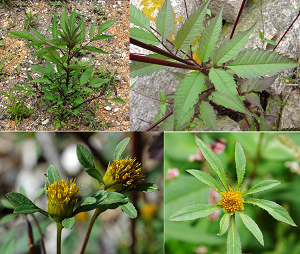Morphological and Micromorphological Investigations of Bidens frondosa L. from Flora of Krasnodar Region, Russia
Abstract
Complex morphological and micromorphological studies have been made about bootjack bur (Bidens frondosa) growing on the territory of the Krasnodar region. The lamina is of dorsoventral type. The conduction system has fasciations, three closed collateral bundles, are present near the vein. The leaf is of amphistomatic type, stomatic apparats are present in a small amount. Anticlinical walls of the main cells of the epidermis are strongly flexuose. The lower epidermis if compared to the upper one has a large number of stomatic apparatus of anisocytic type. The trichomes are leggy, represented by multicellular hairs of different shapes and lengths. Micromorphological capabilities of bootjack bur’s transverse section of the caulis and leafstalk have been studied. Received micromorphological data is a fragment of complex pharmacognostic studies of the Bidens kind. For acquiring the anti-allergic medication in the future, it is necessary to make pharma-technological studies and come up with the necessary medical form in the shape of thick extract and also make pharmacological studies in acquiring this medical form.
Full text article
References
2. Richardson DM, Pyšek P. Plant invasions: merging the concepts of species invasiveness and community invasibility. Prog Phys Geogr. 2006;30(3):409-31. doi: https://doi.org/10.1191/0309133306pp490pr
3. Hayakawa A, Haga M, Wang GX, Yokouchi S, Li W. Reproductive traits associated with invasiveness in Bidens frondosa L. by comparing with a native species, B. tripartita L. in Japan. In Fried G, Bon MC, Brundu G, Brunel S, Chauvel B, Cheptou PO, et al, editors. 4th International Symposium on Environmental Weeds and Invasive Plants. Montpellier: Montpellier SupAgro; 2014. p. 82.
4. Crowe DR, Parker WH. Hybridization and Agamospermy of Bidens in Northwestern Ontario. Taxon. 1981;30(4):749-60. doi:10.2307/1220076
5. Tokarska-Guzik B. The establishment and spread of alien plant species (Kenophytes) in the flora of Poland. Katowice: Wydawnictwo Uniwersytetu Śląskiego; 2005.
6. Konovalov DA, Nasukhova AM. Polyacetylene Compounds in Species of Genus Bidens. Pharm Pharm. 2015;2(2):34-65. doi:10.19163/2307-9266-2014-2-2(3)-34-65
7. Korozhan NV, Buzuk GN. Stabilizing effect of Bidens tripartita herb and Bidens frondosa herb on mast cell membranes. Vestnik Vitebsk State Med Univ. 2015;14(1):136-143.
8. Le J, Lu W, Xiong X, Wu Z, Chen W. Anti-Inflammatory Constituents from Bidens frondosa. Molecules. 2015;20(10):18496-510. doi:10.3390/molecules201018496
9. Rahman A, Bajpai VK, Dung NT, Kang SC. Antibacterial and antioxidant activities of the essential oil and methanol extracts of Bidens frondosa Linn. Int J Food Sci Technol. 2011;46(6):1238-44. doi:10.1111/j.1365-2621.2011.02615.x
10. Serebryanaya FK, Konovalova I. Microscopical Investigation of Sideritis taurica. Borneo J Pharm. 2020;3(3):162-9. doi:10.33084/bjop.v3i3.1524
Authors
Copyright (c) 2023 Vladimir Zinchenko, Fatima Kazbekovna Serebryanaya

This work is licensed under a Creative Commons Attribution-ShareAlike 4.0 International License.
This work is licensed under a Creative Commons Attribution-ShareAlike 4.0 International License.
Authors continue to retain the copyright to the article if the article is published in the Borneo Journal of Pharmacy. They will also retain the publishing rights to the article without any restrictions.
Authors who publish in this journal agree to the following terms:
- Any article on the copyright is retained by the author(s).
- The author grants the journal the right of first publication with the work simultaneously licensed under a Creative Commons Attribution License that allows others to share work with an acknowledgment of the work authors and initial publications in this journal.
- Authors can enter into separate, additional contractual arrangements for the non-exclusive distribution of published articles (e.g., post-institutional repository) or publish them in a book, with acknowledgment of their initial publication in this journal.
- Authors are permitted and encouraged to post their work online (e.g., in institutional repositories or on their websites) prior to and during the submission process. This can lead to productive exchanges and earlier and greater citations of published work.
- The article and any associated published material are distributed under the Creative Commons Attribution-ShareAlike 4.0 International License.




